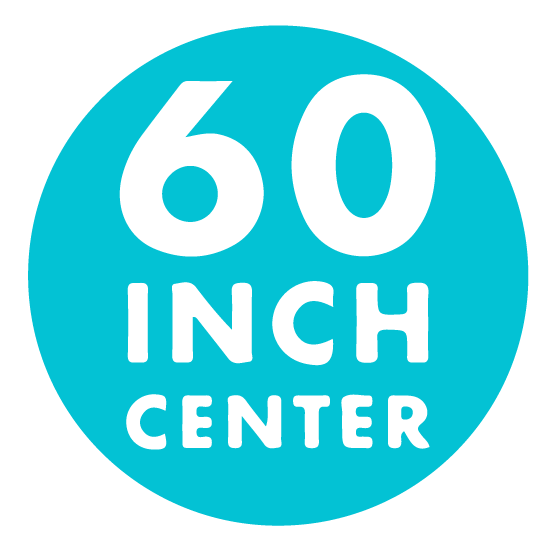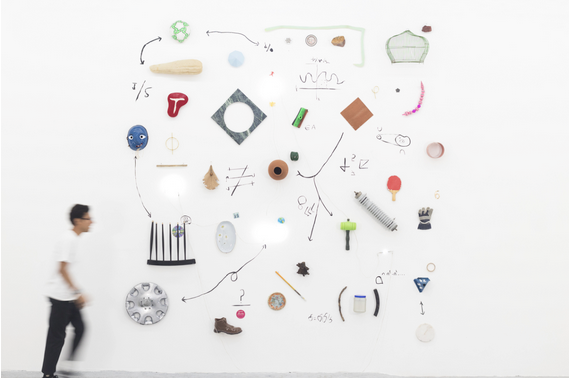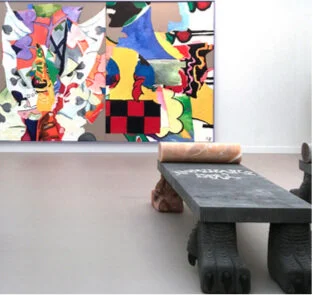Frieze LA: The Exclusive Fair Is Not Just For The Pleasure of Collectors
Frieze is both a publication source for contemporary arts and culture as well as the host of four separate international art fairs that occur every year, the most recent held in Los Angeles. Here, artists Karah Lain and Emma Gerigscott reflect on their experience at Frieze LA:
Frieze LA is a spectacle, and intentionally so: Paramount Pictures Studios is transformed to host the fair, with cobalt blue walls and bright pink curtains grazing the front entrance. And with the $125 price tag for admission, the event clearly caters to a serious crowd of art enthusiasts and social elite. Instantly struck by the glowing white teeth and designer clothes, there was a peculiar alienation felt between the two of us as emerging artists and the buyers in high attendance and even higher tax brackets.
That being said, the artwork did not disappoint and we quickly became absorbed in the work as we zigzagged our way through the booths of the international superstar galleries. Even with the aura of money, money, money thick in the air, every exhibit brought their A game. Compared to past experiences at fairs like Seattle Art Fair and Expo Chicago, Frieze was much smaller, but tighter in its curation, leaving no room for mediocrity. With a price tag for exhibitors of $75,000 per booth, galleries shared nothing but their finest. Despite six-digit prices for some individual pieces, that didn’t stop a steady flow of acquisitions from enthusiastic collectors, nor the most successful booths from selling out completely. (See what sold here)
While each booth was a hit and worth a second visit, there were of course those that stood out. Perhaps as artists, not collectors, we share a minority perspective of Frieze attendees. The art that struck a nerve for us did so not because it was the best buy, but because it did something different. We didn’t need trendy or beautiful art to hang in our penthouses. Rather, we trudged through the three and a half hours of traffic between San Diego to LA to find something new which made us want to go back into our studios and make.
Some galleries like OMR Gallery (Mexico City) showed a collection of artists in conversation, while others such as Galerie Max Hetzler (Paris, Berlin, London) curated their entire booth around one artist. You really couldn’t miss Max Hetzler’s solo exhibition of Norwegian artist Ida Ekblad. The tryptic that made up the focal point of the show involved a coalescing of figurative images, poker cards, nods to digital media, and hints of graffiti, all bound together by the distinct materiality of globby oil paint. Leaving the negative space of the works as exposed linen, Ekblad asks the works to be indisputable as paintings: no trompe l'oeil, no pretending this is anything but paint on canvas. Yet the tactility of paint contrasting the banality of stretched canvas was seductively saccharine and rewardingly engaging.
Ida Ekblad A ball of Malt and Madame Butterfy , 2019 ©Galerie Max Hetzler
The space also featured two stone benches by Ekblad that are reminiscent of the intricate and homey stone carvings one would find outside Portland’s bustling Asian food market, Fubonn. The text on the seat of the benches read “Abominable Girl” and “Sauce More Sauce.” It was an odd and alluring collaging of material and references, like being in an obscure restaurant buffet, where you can get pizza but also California rolls but also imitation crab stir fry—and you want it all. The show was both absorbing in its variety and unified by the singular hand of Ekblad.
Ida Ekblad A ball of Malt and Madame Butterfy , 2019 ©Galerie Max Hetzler
On the subject of collage, OMR gallery stood out to us as having a similarly breezy, cut-and-paste mentality. Showing artists Artur Lescher, Gabriel Rico, Christian Rosa, SUPERFLEX, and Troikaa, each piece, whether sculpture, painting, or installation, maintained a playful confidence. The focal point of the booth was Gabriel Rico’s installation of found objects and imagined hieroglyphs, the arrangement of which implied some kind of unknown cycle or scientific network. It evoked similar qualities of a cave painting, but with contemporary everyday objects and neon lights, connected by expressive symbols painted across the pure white wall.
Gabriel Rico III Mural - reducción objectiva orquestrada (2016-2021), 2019, 124 × 126 × 8 7/10 inches, Mix of found objects (photo courtesy of Artsy.net)
In contrast to big, bright, and spacial work, a painting by artist Gertrude Abercrombie at Karma Gallery (New York) spoke to us. Relatively small (about eight by ten inches), almost unnoticeable among ubiquitous monumental work, this painting featured a tiny black cat sitting in a well-lit scene of blue-toned, gray, and white doors. Abercrombie, a Chicago-based artist, reached the peak of her career in the 1950s. She was committed to making introspective paintings (many of her works feature black cats and other symbols of witchery) and creating condensed expressions of her inner consciousness, in a time when male-macho modernism was center stage. The tiny, delicate painting is an appreciation of the quiet power of inwardness, a historically dismissed notion that one can say a lot while taking up little space. The blue tones in Abercrombie’s painting emit a sense of calm and subdued contentedness, like discovering a bit of shade that was just recently in the sun, asphalt still warm to the touch.
Gertrude Abercrombie Doors and Two Cats, 1956, oil on masonite, 8 x 10 inches (unframed)
Within the fast-paced fair, the buyers and sellers and the bright lights (yes, so bright that one of us did get a migraine later that night), this painting offered a teaspoon of solace. Unassuming yet compelling in its simplicity, Abercrombie represented what we took from Frieze LA – that even the smallest work can give energy, new ways of thinking and being in the world, and an excitement to return to the studio with new fervor.








